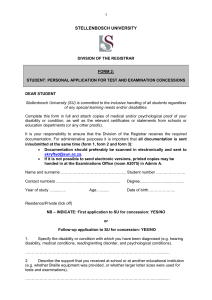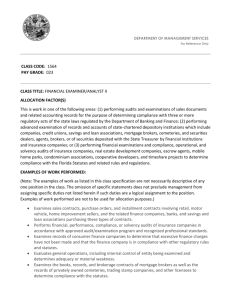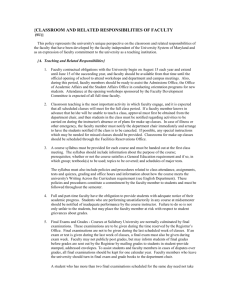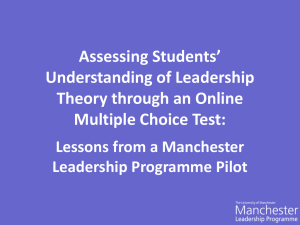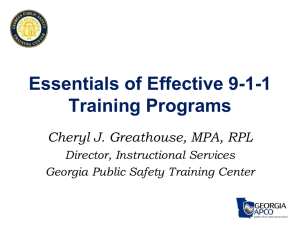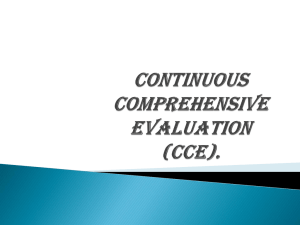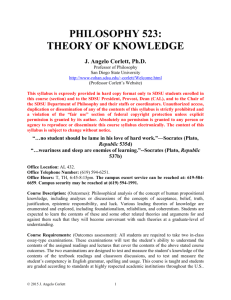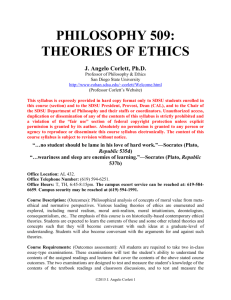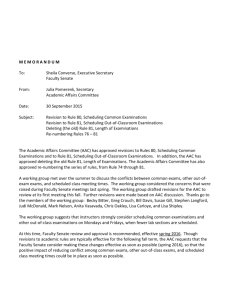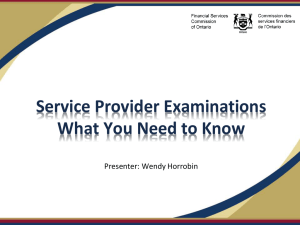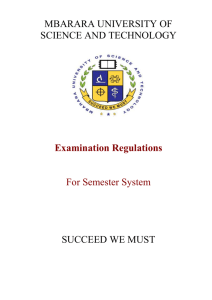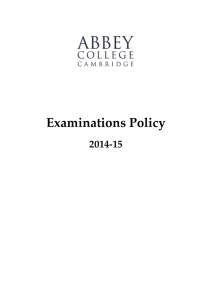Examinations
advertisement
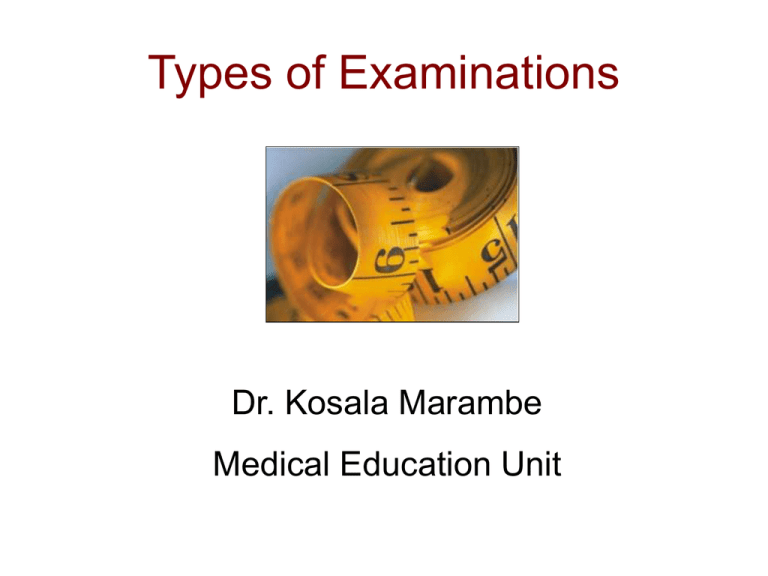
Types of Examinations Dr. Kosala Marambe Medical Education Unit Examinations Examinations Examinations Examinations Examinations - Why? • To find out whether the students have acquired knowledge the set competencies the desirable attitudes Evaluation/Assessments ? • • • • • • • Making a value judgment Measurement Feedback Certification Ranking Motivate learners Direct learning in a desirable direction Streams • SBM Scientific basis of Medicine • CLM Clinical laboratory management • CLR Communication Learning and Research • DIS Doctor in Society • HCT Hospital and community training Year One E E X X S B M & CLM S B M & CLM DIS DIS CLR CLR E L E C T I V E S Types of tests • Formative To give feedback to students To get feedback on how students are progressing • Summative (semester exams) Performance is assessed for certification Formative assessment • Is generally carried out throughout a course or project • Formative assessment, also referred to as "educative assessment," is used to aid learning • In an educational setting, formative assessment might be a teacher (or peer) or the learner, providing feedback on a student's work, and would not necessarily be used for grading purposes • Formative assessments are diagnostic Formative ? • When the cook tastes the soup Summative ? • When the guests taste the soup Continuous assessments • held during the semester • percentage taken for the end semester examination • Could be written tests, practical, assignments, case discussions, student presentations Summative examinations • Semester examinations • Multiple Choice Questions (MCQ) • True false and best answer • Time per each question 3 minutes True/False MCQ Facilitated diffusion (a) requires ATP as an energy source (b) saturates at high solute concentrations (c) requires energy by coupling with an ion gradient (d) transports against the solute concentration gradient (e) involves a carrier protein Best Answer MCQ Hormones are transported out of the cell by (a) (b) (c) (d) (e) pinocytosis phagocytosis exocytosis primary active transport secondary active transport Written Paper • Short answer questions (Listing kind of thing) • Structured Essay questions (15 minutes) • Essay questions (20 to 30 minutes) Practical exams • Objective structured practical examinations (OSPE) • Data interpretation stations • Identify structures - Spots • Role play situations (to test communication) • Viva voce Example of an OSPE • Task - Examine the specimen of urine provided for proteins. • Check list 1. Does he take a urine sample to 2/3 level in the test tube? 2. Does he boil upper 1/3 of the column? 3. Does he add 2% acetic acid drop by drop? 4. Does he compare change in the top layer with the bottom layer of urine? OSCE and OSPE • Similarly, OSCEs and OSPEs can be made for any subject. At the end of the examination, the scores obtained in the procedure stations are totaled to give the candidate score. • Scores at individual stations can also be released to give the candidate a meaningful feedback. In summary • The main features of OSCE/OSPE is that both the process and the product are tested giving importance to individual competencies. • The examination covers a broad range of clinical skills much wider than a conventional examination. • The scoring is objective, since standards of competence are preset and agreed check lists are used for scoring. Where questions are asked in response stations, these are always objective. Viva voce • A panel of examiners (2 or 3) • Ask questions from the examinee • Duration varies ( 5-10 mts) Research report • Assessed using Marking schemes Rating scales Checklists Examinations • Examinations drive learning • Examiners are not “monsters” Format for Examination Years 1 and 2 (Semesters 1 and 2) Scientific Basis of Medicine (SBM) Modules Module Credits Total MCQ duration of Examination SAQ OSPE 1½ 1½ 1½ 1 1 1½ 1½ 1½ 1½ 1½ 1½ ½ 1½ 1½ 1½ 1½ 1½ 2 1½ 1½ 1 - Hours Foundation 4 1½ 6 Respiration 3½ 1 3 Blood and 4 1 6 circulation Alimentation 4 1 6 Excretion and 4 1 7 reproduction Growth 3 1 4 development ageing and nutrition Nervous control 4 1 8 Endocrine 4 1 7 function, homeostasis and metabolism Locomotion 4 1 7 Infection 4 1 4 Integrated 3 1½ 3 Streams Communication Learning and Research (CLR) Year / Semester Credits Duration SAQ/Essay hours Y1S1 Y1S2 Y2S1 Y2S2 2 2 2 2 2 2 2 2 2 2 2 2 Doctor in Society (DIS) Note: Exams only in the second semester of each year Year/ Semester Credit Duration SAQ hours Y1S2 2 2 2 Y2S2 2 2 2 The curriculum instructs teachers what to teach; The exam instructs students what to learn. Donald Melnick, 1991 Take home message • Exams are organized to ensure justice • A range of measurements are used • A number of tools are used Examinations


